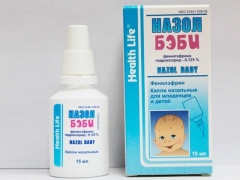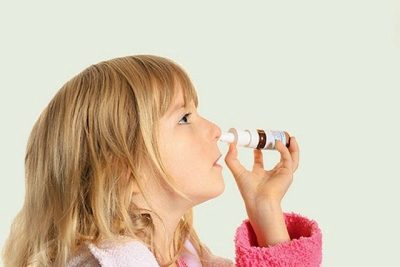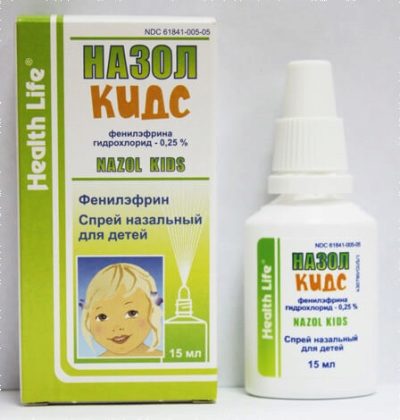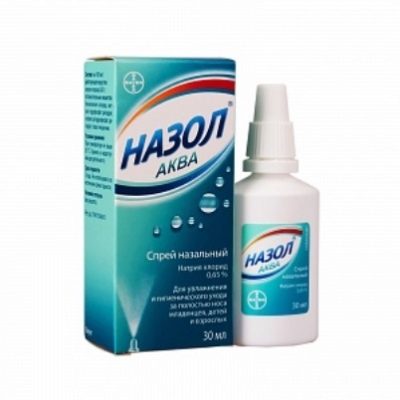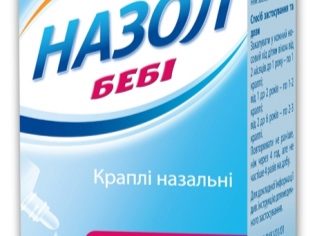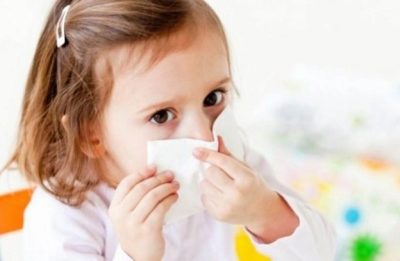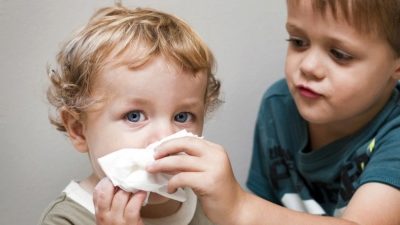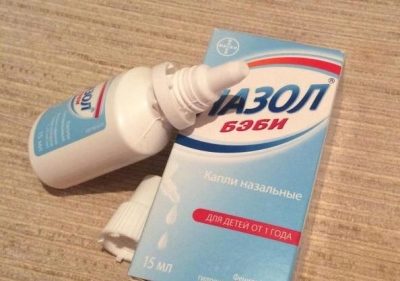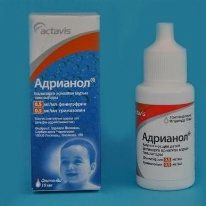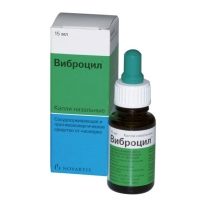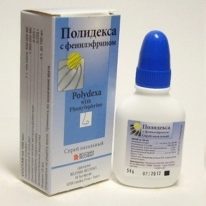Nasol Baby for children: instructions for use
The most popular drugs in the treatment of rhinitis are vasoconstrictor agents, which are injected into the nasal cavity. A representative of such a group of drugs is Nazol Bebi. In what cases is it prescribed for children, at what age and at what dose is it used?
Release form
Nazol Baby comes in the form of nasal drops. The drug is a clear, odorless liquid. Usually such a liquid is colorless, but it can also be light yellow. The solution is sold in plastic bottles with a spout, the capacity of which is 5, 10 and 15 ml, as well as 30 ml.
Composition
The compound that provides nazol baby's drops with a healing effect is phenylephrine hydrochloride. The concentration of such a substance in the preparation is 0.125%, that is, 10025 drops contain 0.125 g of phenylephrine. Auxiliary components are macrogol 1500, purified water, glycerol, potassium dihydrophosphate and benzalkonium chloride. Also, the drug includes disodium edetate and sodium hydrogen phosphate, presented in the form of dihydrate.
A similar composition of the drug is Nazol Kids. The difference is only in the form of release (it is produced in the form of a spray in the nose) and the concentration of phenylephrine (per 100 ml of the drug of the active ingredient contains 0.25 g, therefore the concentration of the solution is 0.25%), as well as the addition of eucalyptol to the composition.
Do not confuse Nazol Baby and Nazol, since the active ingredient of the second drug is another substance - Oxymetazoline. In addition, Nazol is produced only as a spray, so it is used from the age of 6. Oxymetazoline is the main ingredient in the medicine Nazol Advance. It is also represented by a nasal spray and is used at the age of 6 years and older.
Separately, we note the drug Nazol Aqua, in which there are no vasoconstrictor substances. The basis of this nasal spray is sodium chloride at a concentration of 0.65%. It is completely safe for children, therefore it is applied from birth.
Operating principle
Phenylephrine, present in the composition of Nazol Beby, refers to alpha-adrenostimuliruyuschim substances. It activates alpha-adrenoreceptors in the mucous membrane of the nasopharynx, as a result of which the hyperemia and swelling of the tissues decrease, and congestion disappears. The use of such medication helps to improve air permeation through the nasopharynx and alleviates the condition during inflammation of the nasal mucosa.
Indications
Nasol Baby drops are discharged in case of difficulty in nasal breathing, which is noted in allergic rhinitis, acute viral sinusitis or rhinitis, flu, colds and other illnesses.
In this video, Dr. Komarovsky will tell us all about the childhood rhinitis and the most popular medicines for rhinitis.
At what age is it allowed to take?
Instruction for the drops Nazol Bebi specifies that up to the age of six such medication should be used only after consulting a doctor. A pediatrician can prescribe such drops at any age, including children up to one year, if this is indicated by indications.
The drug Nazol Kids is permissible to use from the age of 4, but in children 4-6 years old, this spray is used with extreme caution.
Contraindications
Treatment with nasol nasol drops is prohibited in case of hypersensitivity to the components of the drug. Also, this medication is not prescribed:
- With thyrotoxicosis.
- With hypertension.
- With pathologies of the cardiovascular system.
- With diabetes.
- When treated with MAO inhibitors (including a period of 2 weeks after discontinuation of such drugs).
Side effects
In some children, the use of nazol beby drops leads to tingling, tingling, or burning sensations in the nasopharynx. Very rarely, the children's body reacts to treatment with such a remedy for headaches, tremors, pale skin, increased blood pressure, dizziness, disturbed rhythm of palpitations, sweating, problems with sleep.
Instructions for use
The bottle should be turned upside down and a little push on it so that the drops fall into the nasal passages of a small patient. As soon as the child's nose dripped, the pipette of the bottle must be wiped dry, and then tightly tighten the cap.
The pediatrician determines the dosage of Nazol Baby by age. For babies of the first year of life (for example, for a 3-month-old baby) a single dose will be only one drop in each nostril. Children older than 6 years of age can be buried 1-2 drops, and a child of six years or older - 3-4 drops at once.
Nasol Baby should be put into the nose with an interval of at least 6 hours. The duration of treatment with this medication should not exceed three days.
Overdose
If you use Nazol Baby in too large a dose, it will cause systemic effects, such as headache, nervous agitation, heaviness in the limbs and head, arrhythmic contraction of the heart, hypertension, increased sweating and dizziness. To eliminate these symptoms, alpha- or beta-blockers are prescribed.
Interaction with other drugs
Nazol Baby is not used concurrently with thyroid hormones, tricyclic antidepressants, MAO inhibitors and some other drugs, since this increases the risk of side effects on the heart and blood vessels. In addition, you should not combine treatment with Nasol Baby and other nasal drops in the nose with a vasoconstrictor effect.
Terms of sale
You can buy Nazol Baby at the pharmacy without needing to present a prescription from a doctor. The average price of a bottle of drops with a capacity of 10 ml is 170-190 rubles.
Storage conditions and shelf life
Nazol Baby should be kept at home away from sunlight, and the storage temperature should not exceed the limits from +15 to +30 degrees Celsius. It is very important that such a drug could not accidentally get and drink a small child. The shelf life of the drops is a period of 2 years from the date of production.
Reviews
On the application of Nazol Baby in children respond differently. Most mothers confirm that the drug copes well with clogged nose in babies. Also to the advantages of such drops include the possibility of use from birth.
The shortcomings of the drug are short-acting, inconvenient to use bottle, high price and unpleasant taste. Also, in some children, the drops did not have the expected effect, due to which they had to use another medicine.
Analogs
A replacement for Nazol Baby may be a combination preparation for a cold that contains phenylephrine, for example:
- Adrianol Trimazolin was added to phenylephrine as part of such drops. The medicine in the pediatric dosage is prescribed from the age of 3, and the drug for adults from the age of 7.
- Vibrocil. This medicine is available. in drops, gel and spray. In it, phenylephrine supplemented with dimetindenom, so the drug is in demand for allergic rhinitis. Vibrocil in drops is used in children older than a year, and in other forms - at the age of 6 years and older.
- Polydex with phenylephrine. The composition of this nasal spray includes dexamethasone and 2 antibiotics, so this medicine is prescribed for infectious rhinitis and sinusitis. Its use is permissible in children older than 2.5 years.
In addition, the pediatrician can replace the treatment with Nazol Beby by other means with a similar effect, for example, with oxymetazoline or xylometazoline-based vasoconstrictor, with seawater and others.
In this case, it is necessary to select a replacement for the child together with the doctor. Only a specialist who observes a child can suggest the optimal replacement and determine which is better, for example, Nazol Baby or Nazivin.
Watch the video of Dr. Komarovsky, where everything is as accessible as possible about children's vasoconstrictor drops.
